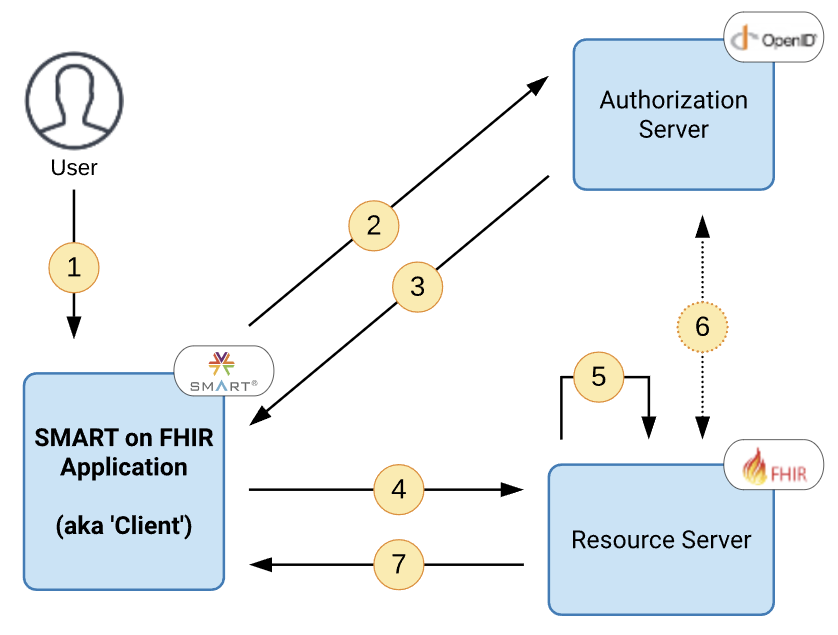SMART App Launch Framework
The Patient Access API
© 2021-2023 Opala. All Rights Reserved.
Version 1.0.1.0
SMART App Launch Framework
© 2021-2023 Opala. All Rights Reserved.
Version 1.0.1.0
SMART  (Substitutable Medical Applications, Reusable Technologies) is an open, standards-based technology platform that enables you to create apps that can span the healthcare system. The specification defines a method through which an app requests authorization to access a FHIR resource, and then uses that authorization to retrieve the resource. The framework supports apps for use by clinicians, patients, and others via a PHR (Personal Health Record), Patient Portal, or any FHIR system where a user can give permissions to launch an app.
(Substitutable Medical Applications, Reusable Technologies) is an open, standards-based technology platform that enables you to create apps that can span the healthcare system. The specification defines a method through which an app requests authorization to access a FHIR resource, and then uses that authorization to retrieve the resource. The framework supports apps for use by clinicians, patients, and others via a PHR (Personal Health Record), Patient Portal, or any FHIR system where a user can give permissions to launch an app.
SMART was started in 2010 and is run out of the Boston Children’s Hospital Computational Health Informatics Program and the Harvard Medical School Department of Biomedical Informatics.
FHIR  (Fast Health Interoperability Resources) is an HL7 specification for Healthcare Interoperability. FHIR uses RESTful web services and open web technologies, including XML (which was used by previous standards), JSON, and RDF data formats.
(Fast Health Interoperability Resources) is an HL7 specification for Healthcare Interoperability. FHIR uses RESTful web services and open web technologies, including XML (which was used by previous standards), JSON, and RDF data formats.
SMART on FHIR  defines a way for health apps to connect to EHR systems with appropriate security guarantees. Its key function is to enable an end user to approve a third-party app to access a specific set of data from a payer or service provider.
defines a way for health apps to connect to EHR systems with appropriate security guarantees. Its key function is to enable an end user to approve a third-party app to access a specific set of data from a payer or service provider.
SMART supports two types of applications: public and confidential. These types of apps are differentiated based on whether the execution environment enables the app to protect secrets. If the application is capable of protecting a client_secret, it's considered confidential; if not, it's public.
Adherence to the SMART on FHIR specification is required by Opala. The specification provides a consistent approach to security and data requirements for health applications. SMART on FHIR defines a workflow that an application can use to securely request access to data, then receive and use that data.
You can think of SMART on FHIR as having three different attributes:
The SMART technology platform enables healthcare organizations to plug third-party medical applications into their clinical data systems. These applications can take several forms:
 . Part of the appeal of the SMART on FHIR specification is that in many cases it is possible to create useful applications without needing to create a backend layer. In other words, a meaningful application can be written in purely HTML + JavaScript + CSS using a SMART on FHIR server as the application backend.
. Part of the appeal of the SMART on FHIR specification is that in many cases it is possible to create useful applications without needing to create a backend layer. In other words, a meaningful application can be written in purely HTML + JavaScript + CSS using a SMART on FHIR server as the application backend.The following illustrates the sequence of events that occurs when a SMART on FHIR web-based application is started.

Application Launch. The user starts the application.
For web-based applications, the user generally follows a link to the application. This link includes parameters specifying the launch context. For example:
https://myapp.com/launch.html?iss=https://app-url.com:8000/baseR4&launch=wd9833
The launch context includes the following parameters:
iss: This parameter provides the base URL for the FHIR server the application should use to fetch data.launch: This parameter typically is a string of random characters that are passed back to the authorization server in order to associate this particular instance of the launch flow across the various steps.In the first step of the launch sequence, the SMART Application fetches the FHIR Server's SMART Discovery Document. This document is a small JSON document hosted at a predictable URL behind the FHIR server that the SMART Application can use to learn more about the authorization requirements of the FHIR server.
To fetch the discovery document, the application appends /.well-known/smart-configuration to the base URL of the FHIR endpoint. For example:
https://app-rul.com:8000/baseR4/.well-known/smart-configuration
The discovery document contains two important URLs:
Request Access. The application directs the user to an OpenID Connect authorization server.
Generally, the user is passed to a third-party website where they are asked to enter credentials (if they aren't already logged in) without the SMART on FHIR application ever knowing what those credentials are. In the case of web applications, this step usually works by having the user follow a link that temporarily takes the user to the third-party authorization server. In the case of mobile applications, a web browser window is temporarily opened on the user's device in order to allow the user to access the authorization server.
When the SMART on FHIR Application directs the user to the authorization server, it also requests a set of OAuth2 Scopes. These scopes are defined in the SMART on FHIR specification. See SMART on FHIR Scopes and Launch Context  for a complete list of scopes defined in the specification. See Supported Scopes in this documentation set or a list of scopes supported by Opala.
for a complete list of scopes defined in the specification. See Supported Scopes in this documentation set or a list of scopes supported by Opala.
Receive Tokens. Once the user has successfully authenticated with the authorization server, they are directed back to the SMART on FHIR application.
As a part of this step, the SMART on FHIR application receives an access token. An access token is a long string of characters that contain the security identity of a process and serve as credentials. Opala uses access tokens in the JSON Web Token (JWT) format. JWTs are small JSON documents that have been digitally signed. These documents contain information about where a token was issued and what application requested it.
The user may also receive two additional tokens:
{
"jti":"155bf20e-5caf-415f-8078-5c896350c828",
"iat":1615563526,
"exp":1615563586,
"aud":"my-client-id",
"sub":"user123",
"iss":"http:\/\/example.com\/issuer",
"given_name":"GIVEN_NAME",
"family_name":"FAMILY_NAME",
"profile":"http:\/\/example.com\/issuer\/fhir\/RelatedPerson\/123",
"nonce":"idihrgy",
"auth_time":1615563526,
"at_hash":"GMPkjip0n0mGmMaOs8HA3w"
}
Client Request to Access or Modify Clinical Data. The application is now able to invoke FHIR services by communicating with the Resource Server. A SMART on FHIR Resource Server is a FHIR server that supports a set of FHIR operations and requires an Access Token as a part of this request.
The request could be a FHIR search operation for discovering data, or a FHIR create operation for uploading newly created data. The scopes that were requested and granted by the authorization server are used to determine whether the user has the appropriate permission to perform the specific function they are invoking. For example:
GET /Observation?subject=Patient/123
Accept: application/fhir+json
Authorization: Bearer eyJraWQiOiJ1b.o_GAe_P5E-y4GrCl.gTYd4is8zAQ
Notice that the call contains an authorization header whose value is the string Bearer followed by the access token. For readability, the token has been shortened (real tokens are much longer).
Validate Token. The Resource Server now validates that the token is acceptable by verifying the digital signature. The token has been digitally signed by the authorization server. The verification uses a public key that can either be provided out-of-band or fetched, as required by the Resource Server. This public key matches a private key held by the authorization server.
As shown in step 4, the token takes a form similar to the following: eyJraWQiOiJ1b.o_GAe_P5E-y4GrCl.gTYd4is8zAQ. The format of the token is called JWT (JSON Web Token), and libraries are available that can be used to decode this token for most languages. Decoding the token results in a JSON document similar to the following:
{
"azp":"my-client-id",
"profile":"http:\/\/example.org:8884\/fhir\/RelatedPerson\/999",
"iss":"http:\/\/example.org:8884",
"exp":1516069149,
"iat":1516069089,
"jti":"95d12878-dd09-4d61-9930-d4b3cf077ec2"
}
Each key in this payload is called a claim, and the claims are defined by the JWT, OAuth2, and OpenID Connect specifications.
azp The ID of the client (SMART application) on whose behalf the token was issued.profile The FHIR resource URL (i.e., a resource ID) that can be used to fetch a resource corresponding to the user who authenticated and requested the token.iss The base URL of the authorization server. According to the OpenID Connect specification, a client can add /.well-known/openid-configuration to this URL to fetch a metadata statement describing the endpoints and functionality of the authorization server.exp The expiry date of the token, specified as the number of seconds since the Unix epoch. The Resource Server can use this claim to determine whether a token is still valid without needing to talk to the authorization server. Because the token is digitally signed, the SMART application is not able to alter this time.iat The time at which the JWT was issued. This claim can be used to determine the age of the token.jti (optional) A unique identifier used to prevent the JWT from being replayed (i.e., this claim allows a token to be used only once).Introspect Token and Request (optional). The application may require more information about the issued tokens. This can include additional details about the user the token was issued for, and information about the token itself, such as its expiration time and associated scopes.
For example, an application sends the following request to the authorization server:
POST /oauth/token/introspect
Accept: application/json
Content-Type: application/x-www-form-urlencoded
Authorization: Basic [client_id and client_secret]
token=eyJraWQiOiJ1b.o_GAe_P5E-y4GrCl.gTYd4is8zAQ
The server sends back the following response, including (in the scope claim) that the user has been approved for a SMART Patient read scope:
{
"active": true,
"scope": "patient/*.read online_access openid profile",
"client_id": "growth_chart",
"token_type": "Bearer",
"exp": 1516069149,
"iat": 1516069089,
"iss": "http://localhost:8884"
}
An app can launch from within an existing EHR or Patient Portal session, known as an EHR launch, or it can launch as a standalone app.
When an app receives a launch request, it requests authorization to access a FHIR resource. It does this by causing the browser to navigate to the EHR's authorization endpoint. Based on pre-defined rules and possibly end-user authorization, the EHR authorization server either grants the request by returning an authorization code to the app's redirect URL or denies the request. The app then exchanges the authorization code for an access token, which the app presents to the EHR's resource server to access requested FHIR resources.
Note: If a refresh token is returned with the access token, the app may use this to request a new access token with the same scope once the current access token expires.
Both the iss and launch parameters are required when requesting an access token. For access tokens, the iss parameter identifies the EHR's FHIR endpoint, which the app can use to obtain additional details about the EHR, including its authorization URL; the launch parameter (an opaque identifier for this specific launch and any EHR context associated with it) passes a launch parameter back to the EHR at authorization time.

